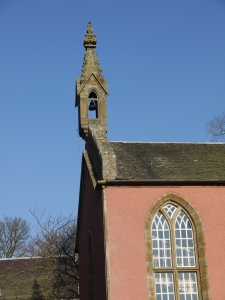
Channelkirk - Childrens Kirk dedicated to the Innocents.
lThrough the ages the church has been referred to as Childenchurch, Childeschirche, Childer-Kirk, Gingle-Kirk, Chingelkirk, Channonkirk and from 1716, Channelkirk. The name perhaps means “Church of the Child” after St.Cuthbert. On the church bell, which was taken down for repairs in 1990 is inscribed CHANNON KIRK 1702.The Bell Tower is pictured below. (Photo : Copyright © H.Jones 2012)
In the Statistical Account of 1885, a further explanation of the name is given as follows: "The ancient name of the parish was Childer-kirk, ie Childrens Kirk, having been dedicated to the Innocents.
 |
| William Holman Hunt - The Triumph of the Innocents. |
The date of Holy Innocents' Day, also called Childermas or Children's Mass, varies. 27 December is the date for West Syrians (Syriac Orthodox Church, Syro-Malankara Catholic Church, and Maronite Church) and East Syrians (Chaldeans and Syro-Malabar Catholic Church). 28 December is the date in theChurch of England, the Lutheran Church and the Roman Catholic Church (in which, except on Sunday, violet vestments were worn before 1961, instead of red, the normal liturgical colour for celebrating martyrs). The Eastern Orthodox Church celebrates the feast on 29 December.
Barrett/Scottish
Saints/St. Cuthbert
Dom Michael Barrett
March 20 – St.
Cuthbert, Bishop, A.D. 687. translation 4 September
This saint was born of Saxon parents in Northumbria, and was early left
an orphan. While tending sheep on the slopes of Lammermoor the youth had a
remarkable vision, in which he saw the heavens at night-time all bright with
supernatural splendour and choirs of angels bearing some soul of dazzling
brightness to its eternal reward. Next day he learned that Aidan, the holy
Bishop of Lindisfarne, had passed away. Cuthbert had often before thought of
embracing the monastic state, and this vision of the blessedness of one who was
a brilliant example of that way of life decided him. He therefore presented
himself at the gates of the monastery of Melrose, being probably in his
twenty-fourth year. He was received as a novice by St. Boisil, the Prior, who,
on first beholding the youth, said to those who stood near: "Behold a true
servant of the Lord," a prediction abundantly fulfilled in Cuthbert's
life.
For ten years the saint remained hidden at Melrose perfecting himself by the routine of monastic observance. Then on the foundation of Ripon he was sent there as one of the first community. After a short stay he returned to Melrose, and on the death of St. Boisil was made Prior. To the greatest zeal for all that concerned monastic life he added a tender charity for the souls of others, which led him to make many missionary excursions into the surrounding territory.
When Abbot Eata in 664 received the charge of the Abbey of Lindisfarne
in addition to Melrose, Cuthbert was sent thither as Prior. For twelve years he
was a teacher to his community, both by word and example, of the precepts of
the perfect life. Then, desiring more strict seclusion, he retired to a
solitary cell on Farne Island, that he might give himself more completely to
prayer. Here he lived eight years, visited on great feasts by some of the
Lindisfarne monks, and at frequent intervals by pious Christians who sought his
direction and intercession.
Having been thus prepared, like St. John Baptist in his desert, for the work God had in store for him, he was chosen Bishop of Lindisfarne. During the two years he exercised this office he was to his flock a model of every virtue, and a pastor full of zeal and charity. He preserved, notwithstanding his high dignity, the humility of heart and simplicity of garb which belonged to his monastic state. Numerous and striking miracles attested his sanctity.
Foreseeing his approaching end he retired to his little cell at Farne where he passed away, strengthened by the Sacraments, with his hands uplifted in prayer. He was buried at Lindisfarne; but incursions of the Danes necessitated the removal of his remains, and for nearly two hundred years his body was conveyed from place to place till it was eventually laid to rest in the Cathedral of Durham. There it became an object of pious pilgrimage from all the three kingdoms. More than 800 years after death the sacred body was found still incorrupt, and there, in a secure hiding-place, it still awaits the restoration of St. Cuthbert's shrine to its rightful custodians, the sons of St. Benedict, the guardians of the secret. Among the churches dedicated to St. Cuthbert in Scotland were those at Ballantrae, Hailes, Ednam, Glencairn, Kirkcudbright, Drummelzier, Glenholm (Broughton), Malton, Edinburgh, Prestwick, Eccles, Drysdale, Girvan, Maybole, Mauchline, Weem, and even distant Wick. Besides Kirkcudbright (Church of St. Cuthbert), which gives the name to a whole county, Northumbria is studded with churches built in his honour, which recall the resting-places of his body, and witness to the devotion inspired by those sacred remains to this great saint. Fairs were formerly held on his feast-day at Ruthwell (Dumfries-shire), and Ordiquhill (Banffshire)--both for eight days--and probably in other localities also. His holy wells were at St. Boswell's and in Strathtay (Perthshire).
A Brief Life and History of St.Cuthbert
http://www.melrose.bordernet.co.uk/mha/5/cuthbert.html

No comments:
Post a Comment